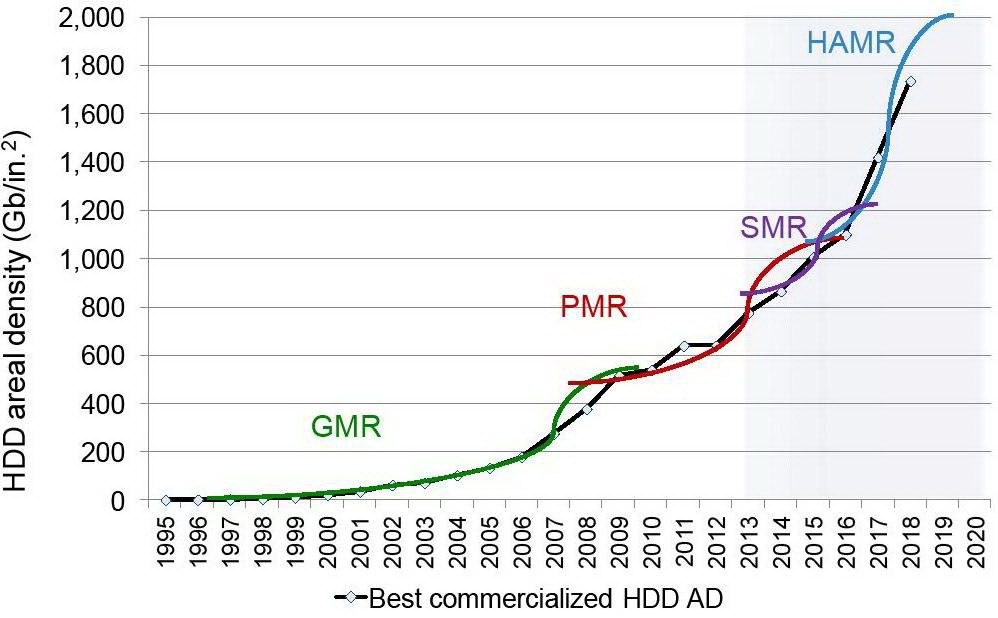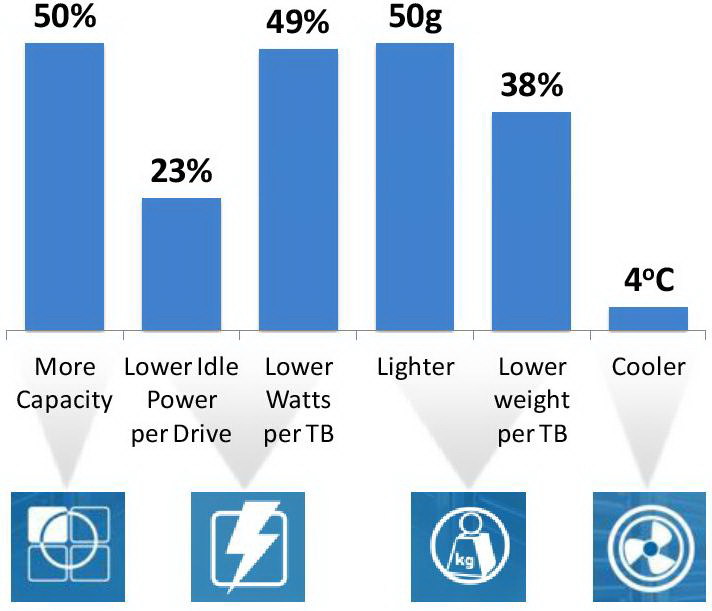HGST HelioSeal - a promising platform for the next decade
Over the past few years, the information processing industry has faced the challenge of rapidly growing data. Several interrelated factors have played a role here - expanding the range of information services (including social networks), the growing popularity of mobile information technology, the need for analyzing large amounts of data. According to IDC estimates, the storage capacity of information and computing centers is growing by more than 40% per year, while the specific capacity of hard drives increases at significantly lower rates - from 2011 to 2016, by less than 20% per year. The need to increase information capacity rests on budgetary constraints, and it is necessary to take into account not only the cost of data storage systems, but also such factors as the power consumed by them and the space occupied.

Fig. 1. Annual growth rates of the aggregate capacity of hard drives supplied for enterprise applications. Source: IDC
As existing methods of recording information on discs reach the peak of their capabilities with respect to recording density, researchers from manufacturing companies are starting to develop new ones. The latest technology introduced to write 1TB of data to a disk plate is called perpendicular magnetic recording (PMR). It is based on the long-known principle of magnetoresistance (GMR - giant magnetoresistive recording). Two promising technologies are shingled magnetic recording (SMR) and thermal assisted magnetic recording (HAMR). Equipment manufacturers are ready for mass deliveries of SMR-based disks, but this method promises a relatively small increase in recording density. As for the HAMR technology, which will give a more significant increase, then it will take from 3 to 5 years to prepare the release of such disks, IDC notes.

Fig. 2. Recording density for various methods (Gbit per square inch). Source: IDC
')
In addition to increasing the recording density, the capacity of hard drives is increased by increasing the number of disk plates in a single package. Up to 7 double-sided plates and, accordingly, 14 heads can be placed in the newest hard drives; a further increase in the number of plates will reduce the reliability of the equipment.
HGST innovation
HGST was able to find a solution to eliminate the existing technical limitations and significantly reduce the gap between the data center needs for data storage and the capabilities of disk technology. The release of helium-filled accumulators will provide a significant increase in technical and economic indicators of disk subsystems.
The advantages of storage tanks filled with helium have been known for a long time, but only recently HGST engineers were able to create reliable hermetic protection suitable for mass production, preventing the outflow of gas to the outside.
Helium is an inert gas that is seven times lighter than air. Its use reduces the resistance to rotation of the discs, so that the disk plates can be made thinner and placed more compactly. Less mass requires less power to rotate. Reducing vibration due to weight reduction improves head positioning accuracy.
HGST HelioSeal sealed discs offer the following benefits:
- increase the recording density due to improved positioning accuracy of the heads;
- increasing the ratio of capacity and price;
- weight reduction of disk drives;
- reduction of electric power consumption;
- reducing the cost of cooling;
- elimination of the risk of damage to equipment due to changes in humidity and the presence of aggressive agents in the atmosphere.
Specifically, the Ultrastar He6 drive with a capacity of 6 terabytes, released in November last year, has the following differences compared to the traditional drive of the same form factor:
- 1.5 times the large capacity;
- 23% less power consumption in idle mode;
- 49% less specific energy consumption (calculated on capacity);
- 38% lower specific gravity (calculated on capacity);
- 4 ° lower heating.

Fig. 3. The advantages of a 6-terabyte HGST disk filled with helium compared to a regular 4-terabyte disk.
When designing modern large information and computing centers (which number tens of thousands of servers that process petabytes or even exabytes of data), they proceed from the principle that the amount of operating expenses is no less important than the amount of capital expenses. Among the most significant items of data center operating costs are power supply and cooling. The table shows an example of the organization of 11-petabyte storage based on conventional 4-terabyte 3.5-inch disks and new Hitachi Helium disks.
Table 1. Characteristics of 11-petabyte storage when using regular disks and disks filled with helium.

Thus, helium-filled hard disk drives promise an increase in operating efficiency in almost all aspects — namely, in terms of capacity, consumed electricity, necessary cooling capacity, and storage density.
Liquid cooling capability
Designers of information processing centers and equipment suppliers, seeking to make rational use of space, increase the density of components of computing systems. In this case, air cooling is not enough, and liquid cooling systems are increasingly used. Conventional liquid disks can be cooled only with the help of heat sinks. HGST HelioSeal discs are completely sealed and can work when immersed in most non-conductive fluids. HGST already collaborates with leading innovative companies in this field, such as Green Revolution Cooling.

Fig. 1. Annual growth rates of the aggregate capacity of hard drives supplied for enterprise applications. Source: IDC
As existing methods of recording information on discs reach the peak of their capabilities with respect to recording density, researchers from manufacturing companies are starting to develop new ones. The latest technology introduced to write 1TB of data to a disk plate is called perpendicular magnetic recording (PMR). It is based on the long-known principle of magnetoresistance (GMR - giant magnetoresistive recording). Two promising technologies are shingled magnetic recording (SMR) and thermal assisted magnetic recording (HAMR). Equipment manufacturers are ready for mass deliveries of SMR-based disks, but this method promises a relatively small increase in recording density. As for the HAMR technology, which will give a more significant increase, then it will take from 3 to 5 years to prepare the release of such disks, IDC notes.

Fig. 2. Recording density for various methods (Gbit per square inch). Source: IDC
')
In addition to increasing the recording density, the capacity of hard drives is increased by increasing the number of disk plates in a single package. Up to 7 double-sided plates and, accordingly, 14 heads can be placed in the newest hard drives; a further increase in the number of plates will reduce the reliability of the equipment.
HGST innovation
HGST was able to find a solution to eliminate the existing technical limitations and significantly reduce the gap between the data center needs for data storage and the capabilities of disk technology. The release of helium-filled accumulators will provide a significant increase in technical and economic indicators of disk subsystems.
The advantages of storage tanks filled with helium have been known for a long time, but only recently HGST engineers were able to create reliable hermetic protection suitable for mass production, preventing the outflow of gas to the outside.
Helium is an inert gas that is seven times lighter than air. Its use reduces the resistance to rotation of the discs, so that the disk plates can be made thinner and placed more compactly. Less mass requires less power to rotate. Reducing vibration due to weight reduction improves head positioning accuracy.
HGST HelioSeal sealed discs offer the following benefits:
- increase the recording density due to improved positioning accuracy of the heads;
- increasing the ratio of capacity and price;
- weight reduction of disk drives;
- reduction of electric power consumption;
- reducing the cost of cooling;
- elimination of the risk of damage to equipment due to changes in humidity and the presence of aggressive agents in the atmosphere.
Specifically, the Ultrastar He6 drive with a capacity of 6 terabytes, released in November last year, has the following differences compared to the traditional drive of the same form factor:
- 1.5 times the large capacity;
- 23% less power consumption in idle mode;
- 49% less specific energy consumption (calculated on capacity);
- 38% lower specific gravity (calculated on capacity);
- 4 ° lower heating.

Fig. 3. The advantages of a 6-terabyte HGST disk filled with helium compared to a regular 4-terabyte disk.
When designing modern large information and computing centers (which number tens of thousands of servers that process petabytes or even exabytes of data), they proceed from the principle that the amount of operating expenses is no less important than the amount of capital expenses. Among the most significant items of data center operating costs are power supply and cooling. The table shows an example of the organization of 11-petabyte storage based on conventional 4-terabyte 3.5-inch disks and new Hitachi Helium disks.
Table 1. Characteristics of 11-petabyte storage when using regular disks and disks filled with helium.

Thus, helium-filled hard disk drives promise an increase in operating efficiency in almost all aspects — namely, in terms of capacity, consumed electricity, necessary cooling capacity, and storage density.
Liquid cooling capability
Designers of information processing centers and equipment suppliers, seeking to make rational use of space, increase the density of components of computing systems. In this case, air cooling is not enough, and liquid cooling systems are increasingly used. Conventional liquid disks can be cooled only with the help of heat sinks. HGST HelioSeal discs are completely sealed and can work when immersed in most non-conductive fluids. HGST already collaborates with leading innovative companies in this field, such as Green Revolution Cooling.
Source: https://habr.com/ru/post/211014/
All Articles